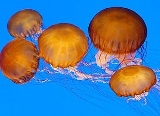
Cnidaria
Overview
Cnidaria is a phylum containing over 9,000 species
of animal
s found exclusively in aquatic and mostly marine
environments. Their distinguishing feature is cnidocyte
s, specialized cells that they use mainly for capturing prey. Their bodies consist of mesoglea
, a non-living jelly-like substance, sandwiched between two layers of epithelium
that are mostly one cell thick
. They have two basic body forms: swimming medusa
e and sessile
polyp
s, both of which are radially symmetrical with mouths surrounded by tentacles that bear cnidocytes.
Species
In biology, a species is one of the basic units of biological classification and a taxonomic rank. A species is often defined as a group of organisms capable of interbreeding and producing fertile offspring. While in many cases this definition is adequate, more precise or differing measures are...
of animal
Animal
Animals are a major group of multicellular, eukaryotic organisms of the kingdom Animalia or Metazoa. Their body plan eventually becomes fixed as they develop, although some undergo a process of metamorphosis later on in their life. Most animals are motile, meaning they can move spontaneously and...
s found exclusively in aquatic and mostly marine
Ocean
An ocean is a major body of saline water, and a principal component of the hydrosphere. Approximately 71% of the Earth's surface is covered by ocean, a continuous body of water that is customarily divided into several principal oceans and smaller seas.More than half of this area is over 3,000...
environments. Their distinguishing feature is cnidocyte
Cnidocyte
A cnidocyte, cnidoblast, or nematocyte is a type of venomous cell unique to the phylum Cnidaria . The cnidocyte cell provides a means for them to catch prey and defend themselves from predators. Despite being morphologically simple, lacking a skeleton and usually being sessile, cnidarians prey on...
s, specialized cells that they use mainly for capturing prey. Their bodies consist of mesoglea
Mesoglea
Mesoglea is the translucent, inert, jelly-like substance that makes up most of the bodies of jellyfish, comb jellies and certain primitive sea creatures in the phyla Cnidaria and Ctenophora. It acts as the creatures' structural support in water, as they lack bones or cartilage, endo- or...
, a non-living jelly-like substance, sandwiched between two layers of epithelium
Epithelium
Epithelium is one of the four basic types of animal tissue, along with connective tissue, muscle tissue and nervous tissue. Epithelial tissues line the cavities and surfaces of structures throughout the body, and also form many glands. Functions of epithelial cells include secretion, selective...
that are mostly one cell thick
Cell (biology)
The cell is the basic structural and functional unit of all known living organisms. It is the smallest unit of life that is classified as a living thing, and is often called the building block of life. The Alberts text discusses how the "cellular building blocks" move to shape developing embryos....
. They have two basic body forms: swimming medusa
Medusa (biology)
In biology, a medusa is a form of cnidarian in which the body is shaped like an umbrella, in contrast with polyps. Medusae vary from bell-shaped to the shape of a thin disk, scarcely convex above and only slightly concave below...
e and sessile
Sessility (zoology)
In zoology, sessility is a characteristic of animals which are not able to move about. They are usually permanently attached to a solid substrate of some kind, such as a part of a plant or dead tree trunk, a rock, or the hull of a ship in the case of barnacles. Corals lay down their own...
polyp
Polyp
A polyp in zoology is one of two forms found in the phylum Cnidaria, the other being the medusa. Polyps are approximately cylindrical in shape and elongated at the axis of the body...
s, both of which are radially symmetrical with mouths surrounded by tentacles that bear cnidocytes.
Unanswered Questions
Discussions

